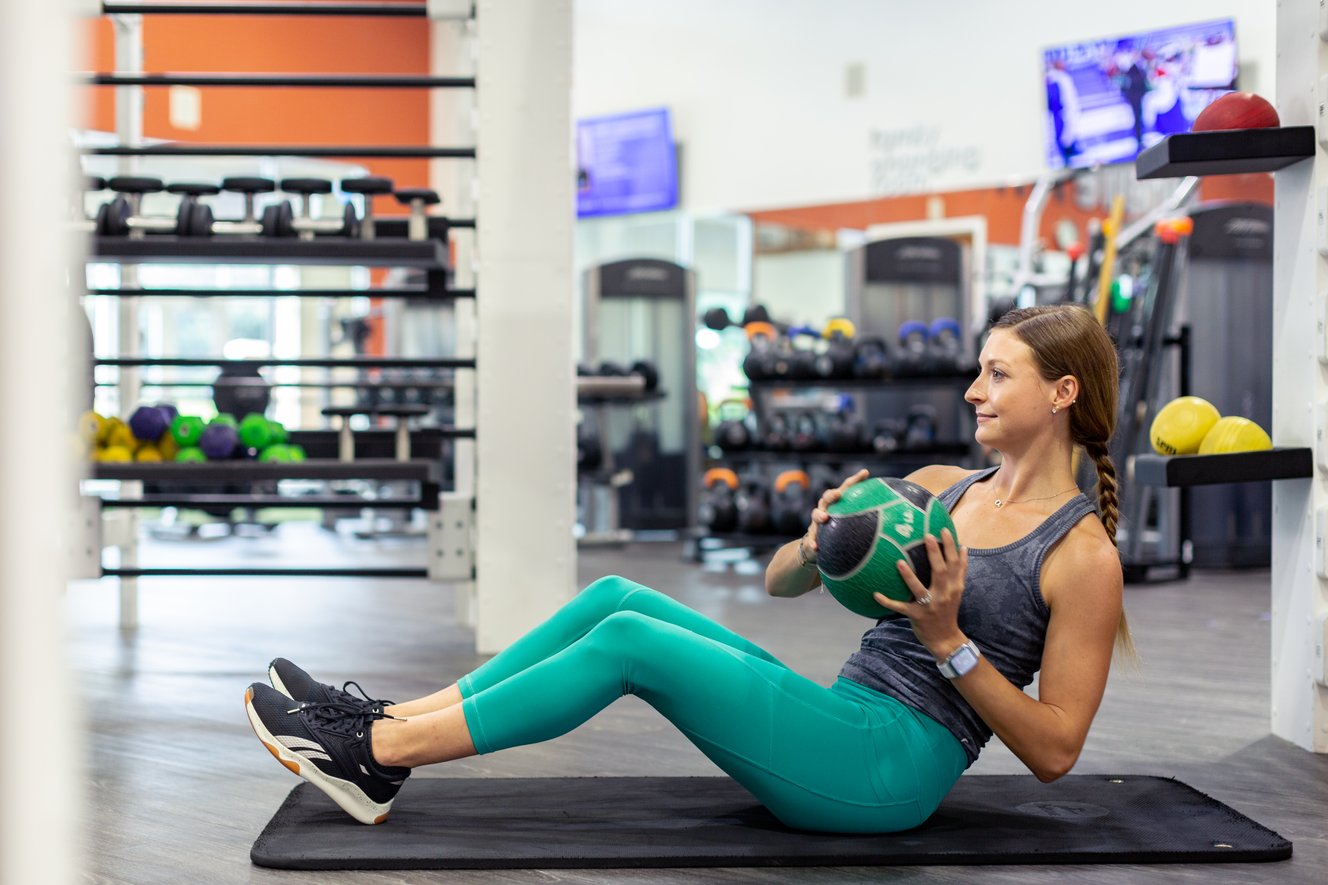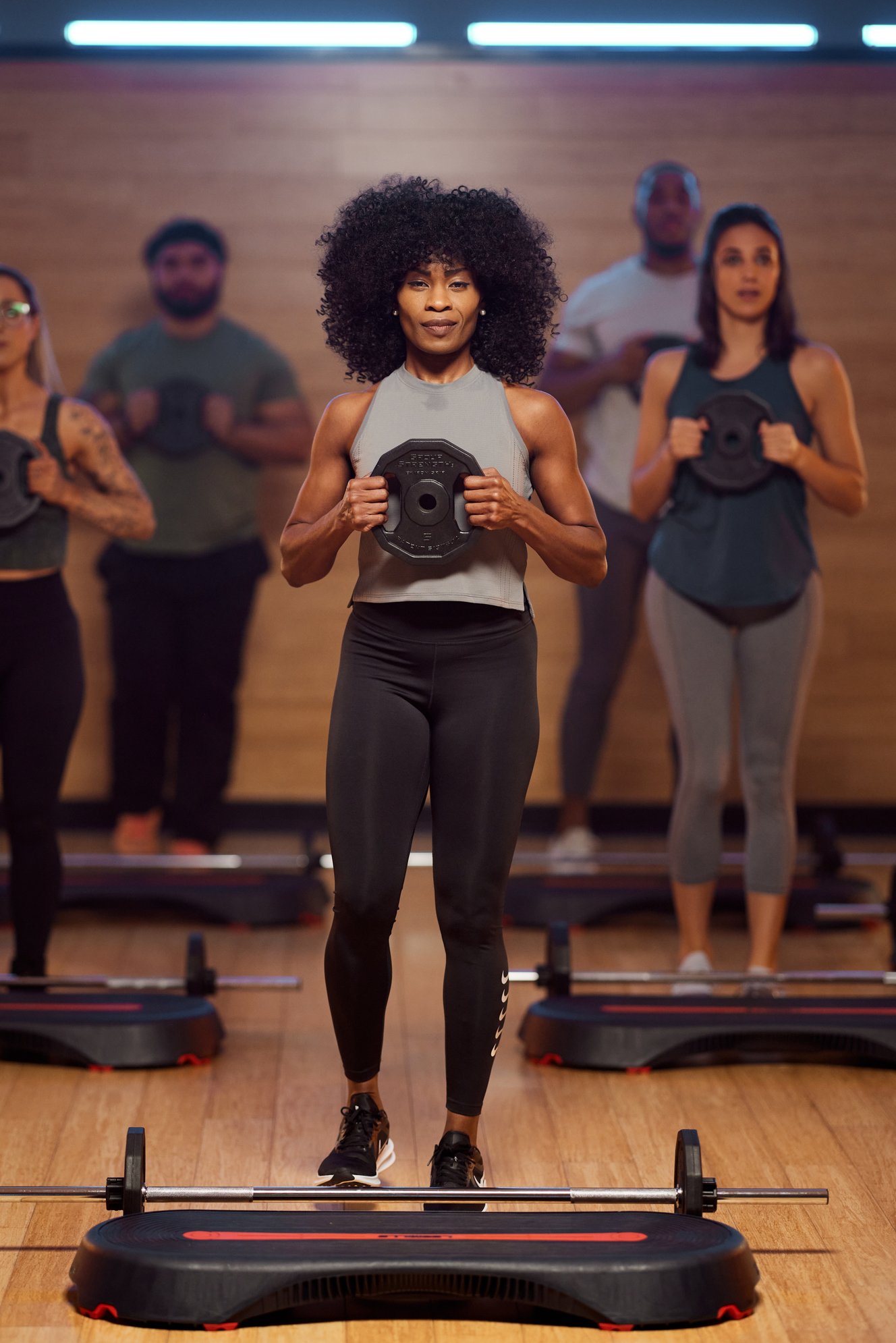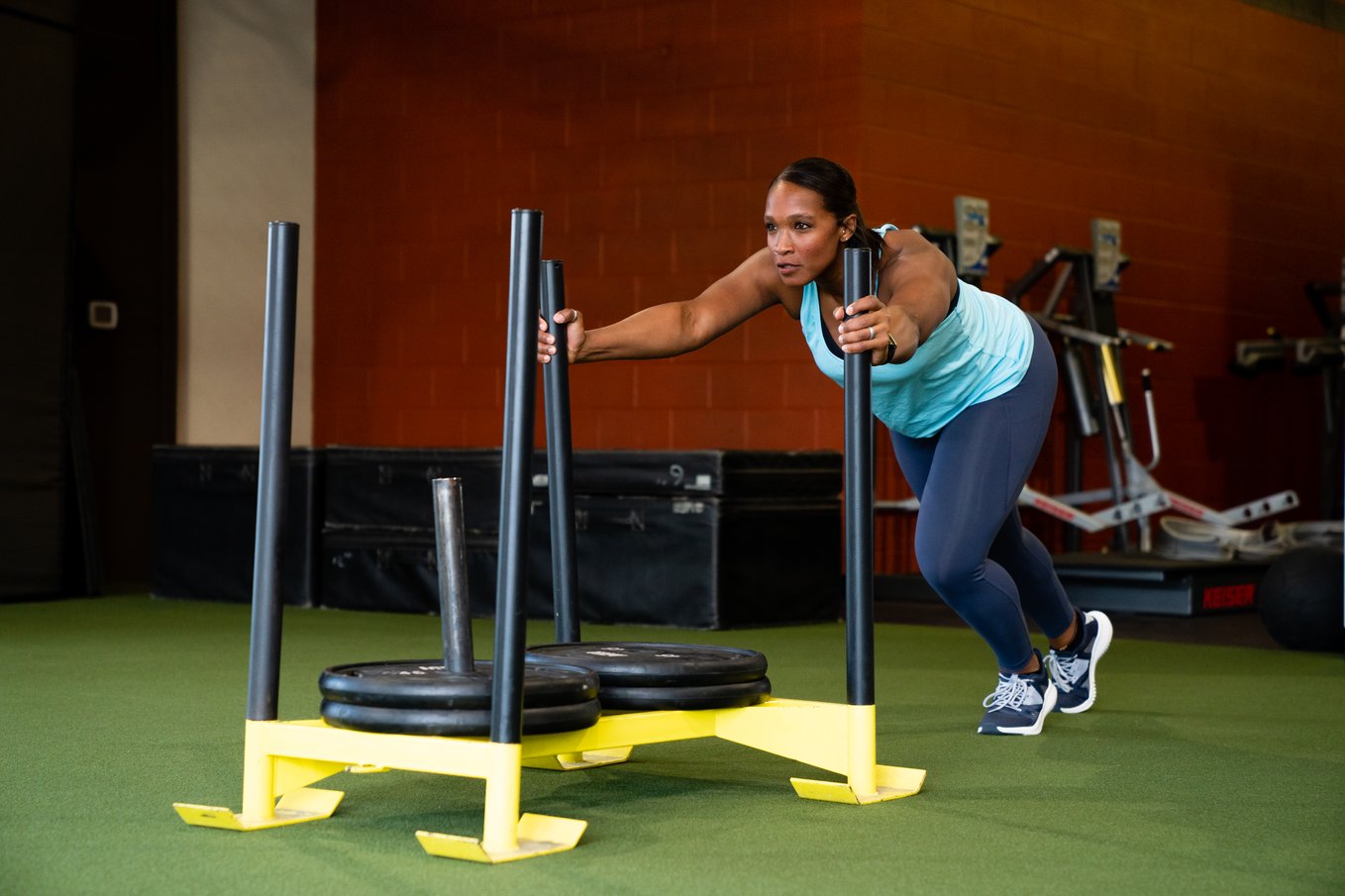Beginner Muscle Building Workout
Beginner Muscle Building Workout
Recall the thrill of pedaling a bike for the first time? That's what starting your muscle-building journey can feel like - thrilling yet daunting. But just as you mastered cycling with practice and patience, you too can conquer this.
Maybe you've toyed around with weights or tried some random exercises on YouTube. Perhaps you're seeking more structure to strengthen effectively without wasting precious time.
Welcome aboard! This is where we strip away myths about lifting heavy from day one or gulping down gallons of protein shakes daily. Instead, let's dive into understanding how muscles grow and why nutrition matters as much as exercise.
We'll discuss realistic goal setting before kick-starting any serious workout program or regimen. We'll explore essential equipment for home workouts because not everyone can access a gym immediately.
Ready to work out? Get your FREE PASS from Onelife Fitness today!
Understanding the Basics of Muscle Building
The first step to building muscle is understanding how muscles grow. When you work out, your body replaces or repairs damaged muscle fibers through a cellular process that fuses them to form new protein strands or myofibrils. These repaired myofibrils increase in number and thickness to create hypertrophy (growth), as this study explains.
Muscle enlargement transpires when the rate of protein fabrication is superior to that of muscle protein synthesis and breakdown. But it's not all about pumping iron. Nutrition plays an essential role, too.
Nutrition: Fuel for Your Muscles
Your diet needs enough calories and protein because these nutrients provide energy for workouts and recovery after them. Protein also for body fat loss helps build new muscle tissue - aim for a protein intake of around 1 gram per pound of body weight daily.
Fats are crucial to stimulating muscle growth, too. They support many bodily functions like hormone production, which can help promote muscle growth, according to research published by The American Journal of Clinical Nutrition.
The Role Of Rest In Muscle Recovery And Growth
Rest days are vital because that's when your muscles get a chance to repair themselves from intense weight training and sessions – leading directly into growth.
It would be best to have adequate sleep; seven hours minimum, but preferably eight to nine per night will do wonders on this journey.
If you don't give your body time to heal, chances are high you'll hit plateaus fast with little progress made over time.
Understanding these basics of muscle building can help beginners make the most out of their workouts and see results faster. Remember, consistency is key, so stick to your plan even when progress seems slow.
Preparing for Your Muscle-Building Journey
Before beginning your strength-building expedition, specific fundamental measures should be taken. First up is setting realistic goals. These will be your road map on this muscle-building journey.
Your goal could be as simple as wanting to feel stronger or more complex as gaining a specific amount of lean muscle mass. But remember, it's not about overnight success. Mayo Clinic advises that gradual gains in muscle strength and size over time lead to more muscle gain and the best long-term results.
A Health Check-Up: Not Optional.
A critical step often overlooked by beginners is getting a health check-up before starting any new workout regimen. This helps identify potential issues that might affect your ability to train safely.
You wouldn't want an underlying heart condition or joint issue cropping up mid-deadlift. Ensure you obtain the go-ahead from your physician before beginning any exercise routine.
Nutrition: Fueling Your Gains
Besides lifting weights, proper nutrition plays a critical role in building muscles. It's fuel for your workouts and recovery periods after each training session.
The right balance of proteins, carbs, and fats can optimize both performances during workouts and muscle repair afterward, according to the American College of Sports Medicine.
Mental Preparation: A Game-Changer
Last but not least, prepare your mind. You're about to embark on a journey that's as much mental as it is physical.
Muscle building can be tough, and there will be days when you'll want to quit. That's why cultivating a strong mindset from the get-go is essential for success in this game.
Essential Equipment for Home Workouts
Working out at home doesn't mean you need a room full of fancy gym equipment. But some basic items can make your workouts more effective and enjoyable.
Dumbbells
A pair of dumbbells is the cornerstone of any home workout gear. They're adaptable, taking up minimal room, and can be utilized for weight lifting and a broad scope of activities to construct muscle quality.
Resistance Bands
Resistance bands are another great option for building muscle at home. They offer variable resistance, which increases as you pull exercises the band stretches - an excellent way to challenge your muscles.
Pull-Up Bar
The pull-up bar might seem intimidating initially, but it's incredibly beneficial when incorporated into your routine correctly. It allows you to perform a variety of exercises targeting different upper-body muscles. Bonus: You don't need much weight or space.
Kettlebell
A kettlebell, a heavyweight champion in the world of fitness tools, offers compound movements and free weights that work multiple muscles simultaneously– delivering efficient whole-body workouts.
Foam Roller
Last but not least: foam roller. Often overlooked, this tool is essential for post-workout recovery because it helps to relieve muscle tension and increase blood flow.
Remind yourself the key factor is not what supplies you own but how many calories with how much weight and how consistently you utilize them. So get out there (or stay in) and start building those muscles.
Understanding Different Types of Exercises

Different exercises target different muscle groups. By understanding the specifics, you can optimize your workout for better muscle building.
Compound Exercises
Compound exercises work multiple muscles at the same weight at once and are great for beginners because they give more bang for your buck. They help build strength faster by involving multiple joints and muscles working together. For instance, squats work not just your quads but also your glutes, hamstrings, and core.
Isolation Exercises
In contrast, push exercises are used to compound movements, and isolation exercises focus on one specific muscle group at a time. Think bicep curls or calf raises—these workouts let you hone in on individual areas that might need more attention.
Aerobic vs Anaerobic Exercise
Beyond these categories lies another distinction: aerobic versus anaerobic exercise. Aerobic activities like running or swimming rely heavily on oxygen to fuel the body. An anaerobic workout such as weightlifting involves quick bursts of energy without using oxygen directly. This is what drives muscular growth.
Plyometrics
Finally, we have plyometrics. Plyometric exercises, such as box jumps or burpees, combine strength and speed to improve power - think of them like the cherry on top of your muscle-building sundae.
So now you know. Whether compound movements for overall strength, isolation workouts for targeted gains, aerobic vs anaerobic exercise for fueling methods, or plyometrics for power—each has its place in a well-rounded workout plan.
A Beginner's Guide to Proper Form and Technique
.jpg?width=1328&height=886&name=211119_OneLife_Shot01_UpperTurf_0155F%20(1).jpg)
When beginning your muscle-building journey, mastering the fundamentals of form can be essential for achieving maximum results and avoiding injury. Proper technique not only helps maximize gains but also keeps injuries at bay.
The Importance of Correct Posture
Good posture is a cornerstone for effective workouts. It ensures that your body parts are correctly aligned, allowing muscles to be targeted accurately during exercises.
Maintaining good posture might seem tricky at first, but with time, it becomes second nature. To help get this right from day one, consider enlisting a personal trainer or seeking advice from seasoned gym-goers.
Focusing on Controlled Movements
Rushing through reps won't bring faster results; instead, slow and controlled movements ensure every fiber gets its share of strain. These actions lead to muscle hypertrophy (growth), which we want.
Practicing this technique effectively requires patience - don't rush. Remember that quality beats quantity every single time when it comes to building muscles.
Breathing Right During Workouts
You'd think breathing would come naturally—but not always during exercise. When lifting weights especially, remember to exhale on exertion (like pushing or pulling) and inhale as you return.
This tip will let oxygen flow better through your muscles and warm your entire body, ensuring your muscles have the energy they need for those tough reps. And remember, never hold your breath during a lift—it's unsafe.
Staying Consistent with Form and Technique
Building muscle isn't about flitting from one workout fad to another; it's all about consistency in form and technique. When you keep up proper form consistently, you'll make sure that each rep brings you closer to your goals.
So stick with it—even when progress seems slow. Muscle growth takes time but will pay off if patience is part of your game plan.
Sample Beginner Muscle Building Plan

For the seasoned weightlifter, this introductory muscle-building regimen should not pose a challenge. Here's a simple workout plan to help you get started. This routine uses isolation and compound exercises for all major muscle groups.
Day 1: Chest and Triceps
The first day targets your chest and triceps. Start with bench presses to work on your pectoral muscles. Then move onto dumbbell flyes for more pec engagement. Bench press benefits go beyond just chest strengthening - it works your triceps, too.
Add in some skull crushers (don't worry, they're not as scary as they sound), which specifically focus on the tricep muscles at the back of your upper arm.
Day 2: Back and Biceps
Your back and biceps will feel challenged with this lineup of pull-ups, bent-over rows, deadlifts, and hammer curls. Deadlifts are key players, working out multiple muscle groups, including lower-back muscles.
Day 4: Legs
Squats are an essential leg exercise that primarily targets the quads and strengthens hamstrings. Pair them with lunges – another great total-leg builder - plus calf raises for those often overlooked lower legs. Learn why squats and lunges are crucial for leg day here.
Day 6: Shoulders and Abs
The final workout of the week is all about your shoulders and abs. Dumbbell shoulder presses, lateral raises, and front raises make a great combo to target different parts of your shoulders. Add in some planks and crunches for an ab-tastic finish.
Note that rest days are as important as workout days because muscles grow during rest day recovery periods.
Remember, consistency over intensity will get you results when starting. Happy lifting.
Tips for Staying Motivated and Consistent
Building muscle to lose weight is a marathon, not a sprint. But how do you stay motivated on this long journey? To help you stay motivated on your long journey to lose fat, here are some tips.
Set Realistic Goals
The first step towards consistency in any workout regimen is setting realistic goals. Start with what's achievable now, then gradually aim higher as your strength improves. Remember, it takes time to build something great. It helps to jot down these goals somewhere visible - research shows it can improve success rates by 42%.
Create A Routine You Enjoy
Your workout routine shouldn't feel like punishment. Find exercises you enjoy doing so that each session becomes something to look forward to rather than dread. Experimenting with different routines at our Onelife Fitness gyms could make things more exciting.
Celebrate Your Progress
No matter how small the victory might seem – be it lifting heavier or lighter weights or noticing firmer muscles – celebrate them all. These little wins will fuel your motivation tank and drive you further along the path of consistent workouts.
Mix Up Your Workouts
To prevent boredom from setting in and derailing your progress, mix up your workouts regularly. Trying new equipment or attending one of Onelife's fitness classes may give the spark needed for an energetic workout session.
Buddy Up
Exercising with a companion can be amusing, but it also assists in maintaining you responsible. Knowing someone else is relying on you to show up might give you the push needed to keep going.
Reward Yourself
Don't forget to give yourself a pat on the back. It's not about overeating or skipping gym sessions. Rather, why not spoil yourself with some new workout gear? Or perhaps unwind with a soothing spa day at our Onelife Fitness amenities.
Dealing with Common Challenges and How to Overcome Them

Muscle building, especially for beginners, is often a path laden with obstacles. But fear not. Every challenge has a solution waiting just around the corner.
The Challenge of Soreness
Sore muscles are almost an inevitable part of starting to build muscle. You're asking your body to do more than it's used to - but that doesn't mean you need to suffer in silence.
A study published by The Journal of Pain suggests gentle exercise can help ease muscle soreness after intense workouts.
Finding Time for Body Workouts
We all lead busy lives, and finding time to fit in regular workouts can be challenging. The good news? It doesn't have to take hours out of your day.
You'll get significant benefits from shorter, more frequent sessions, according to research conducted by ACSM's Health & Fitness Journal.
Eating Right For Muscle Growth
Nourishment is an essential factor in building muscle mass, muscular endurance, and recovery. Getting this right can seem overwhelming at first glance - but it doesn't have to be complicated.
Cleveland Clinic's guide to eating for your metabolism is a great place to start.
The Challenge of Consistency
Maintaining regularity is vital for muscle development; however, actually following through can be challenging. It's not just about hitting the gym - it's about making fitness a part of your lifestyle.
Remember, every challenge presents an opportunity for growth and progress.
FAQs
How should I start working out to gain muscle?
Start slow, focus on learning proper form, gradually add weight, and increase your workout program intensity. Combine strength training with adequate nutrition and rest for optimal results.
What is a good beginner workout routine?
A solid beginner routine includes a full-body routine and full-body workouts three times at least per week. It can combine compound exercises like squats, bench presses, and deadlifts with isolation movements such as bicep curls or calf raises.
How many reps should I do to build muscle as a beginner?
Aim for 8-12 reps per set in your workouts. This range of 10 reps is known to promote hypertrophy (muscle growth) effectively while helping you learn the correct technique.
How do newbies build muscle fast?
Newbies can accelerate muscle growth by focusing on progressive overload - continually increasing muscle size, weight, or number of 3 set repetitions in their exercise routines over time – along with proper diet and recovery practices.
Conclusion
You've taken the first step on your beginner muscle-building workout journey. You now know how muscles grow and why nutrition is critical to gaining muscle,
Remember, preparation before starting any training program or any regimen matters. We highlighted essential home workout equipment to get you started.
Different exercises target different muscles - a crucial point in planning workouts effectively. Proper form and technique? They're non-negotiables for injury prevention and optimal gains.
We shared a sample beginner's plan with isolation and compound exercises that cover all major muscle groups. Staying motivated might be challenging, but remember, consistency brings results!
Facing challenges is part of the process, yet overcoming them makes success sweeter. So go forth! Start strong on this exciting road to fitness transformation!
Contact Onelife Fitness for your FREE PASS and all our gym classes across WV, DC, VA, MD, & GA. We look forward to helping you on your health and fitness journey!